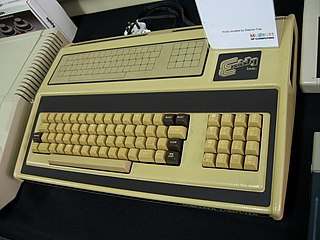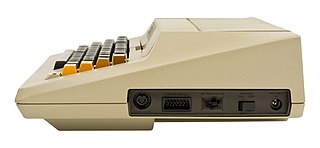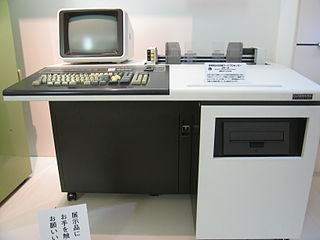A cassette magazine, or tapezine, is a publication contained entirely on computer-readable media, specifically on cassette. Its content consists of some combination of text, graphics, multimedia, and executable programs, and it is normally specific to one particular computer platform or operating system. The successor to the cassette magazine was the disk magazine.

A disk magazine, colloquially known as a diskmag or diskzine, is a magazine that is distributed in electronic form to be read using computers. These had some popularity in the 1980s and 1990s as periodicals distributed on floppy disk, hence their name. The rise of the Internet in the late 1990s caused them to be superseded almost entirely by online publications, which are sometimes still called "diskmags" despite the lack of physical disks.
Early home and hobby users of personal computers in the late 1970s and early 1980s sometimes typed in programs, usually in the BASIC language, which were published in the computer magazines of the time. This was a lot of work, and prone to error, so the idea of publishing a magazine directly on a computer-readable medium so that the programs could be run directly without typing came independently to several people.

BASIC is a family of general-purpose, high-level programming languages whose design philosophy emphasizes ease of use. In 1964, John G. Kemeny and Thomas E. Kurtz designed the original BASIC language at Dartmouth College. They wanted to enable students in fields other than science and mathematics to use computers. At the time, nearly all use of computers required writing custom software, which was something only scientists and mathematicians tended to learn.
Some ideas of putting bar codes into paper magazines, which could be read into a computer with the appropriate peripheral, were floated at the time, but never caught on. Since the common data storage medium of the earliest home computers was the audio cassette, the first magazine published on a physical computer medium was cassette magazine; CLOAD magazine, for the Radio Shack TRS-80 computer, began publication in 1978, named after the command to load a program from cassette on that computer system. Shortly afterwards, in July 1978, the first issue of CURSOR magazine was released for the Commodore PET.

The TRS-80 Micro Computer System is a desktop microcomputer launched in 1977 and sold by Tandy Corporation through their RadioShack stores. The name is an abbreviation of Tandy/RadioShack, Z-80 microprocessor. It is one of the earliest mass-produced and mass-marketed retail home computers.

The Commodore PET is a line of home/personal computers produced starting in 1977 by Commodore International. A top-seller in the Canadian and United States educational markets, it was the first personal computer sold to the public and formed the basis for their entire 8-bit product line, including the Commodore 64. The first model, which was named the PET 2001, was presented to the public at the Winter Consumer Electronics Show in 1977.
CLOAD was not the first electronic periodical, however, because various ARPANET digests had been published as text files sent around the network since the early 1970s. These, however, were pure ASCII text and hence were not cassette magazines or disk magazines by the current definition. Also, at the time, few people outside of academic institutions had access to this forerunner of the Internet.

The Advanced Research Projects Agency Network (ARPANET) was an early packet-switching network and the first network to implement the TCP/IP protocol suite. Both technologies became the technical foundation of the Internet. The ARPANET was initially funded by the Advanced Research Projects Agency (ARPA) of the United States Department of Defense.

The Internet is the global system of interconnected computer networks that use the Internet protocol suite (TCP/IP) to link devices worldwide. It is a network of networks that consists of private, public, academic, business, and government networks of local to global scope, linked by a broad array of electronic, wireless, and optical networking technologies. The Internet carries a vast range of information resources and services, such as the inter-linked hypertext documents and applications of the World Wide Web (WWW), electronic mail, telephony, and file sharing.

The Apple II series is a family of home computers, one of the first highly successful mass-produced microcomputer products, designed primarily by Steve Wozniak, manufactured by Apple Computer, and launched in 1977 with the original Apple II. In terms of ease of use, features, and expandability, the Apple II was a major advancement over its predecessor, the Apple I, a limited-production bare circuit board computer for electronics hobbyists. Through 1988, a number of models were introduced, with the most popular, the Apple IIe, remaining changed relatively little into the 1990s. A 16-bit model with much more advanced graphics and sound, the Apple IIGS, was added in 1986. While compatible with earlier Apple II systems, the IIGS was in closer competition with the Atari ST and Amiga.

The Apple II is an 8-bit home computer, one of the first highly successful mass-produced microcomputer products, designed primarily by Steve Wozniak. It was introduced in 1977 at the West Coast Computer Faire by Jobs and was the first consumer product sold by Apple Computer, Inc. It is the first model in a series of computers which were produced until Apple IIe production ceased in November 1993. The Apple II marks Apple's first launch of a personal computer aimed at a consumer market – branded towards American households rather than businessmen or computer hobbyists.

A word processor is an electronic device or computer software application that performs the task of composing, editing, formatting, and printing of documents.

A microcomputer is a small, relatively inexpensive computer with a microprocessor as its central processing unit (CPU). It includes a microprocessor, memory, and minimal input/output (I/O) circuitry mounted on a single printed circuit board. Microcomputers became popular in the 1970s and 1980s with the advent of increasingly powerful microprocessors. The predecessors to these computers, mainframes and minicomputers, were comparatively much larger and more expensive. Many microcomputers are also personal computers.

The Sorcerer is one of the early home computer systems, released in 1978 by the videogame company Exidy. It was comparatively advanced when released, especially when compared to the contemporary more commercially successful Commodore PET and TRS-80, but due to a number of problems, including a lack of marketing, the machine remained relatively unknown, and Exidy eventually pulled it from the market in 1980.

Typesetting is the composition of text by means of arranging physical types or the digital equivalents. Stored letters and other symbols are retrieved and ordered according to a language's orthography for visual display. Typesetting requires one or more fonts. One significant effect of typesetting was that authorship of works could be spotted more easily, making it difficult for copiers who have not gained permission.
Apple DOS is the family of disk operating systems for the Apple II series of microcomputers from late 1978 through early 1983. It was superseded by ProDOS in 1983. Apple DOS has three major releases: DOS 3.1, DOS 3.2, and DOS 3.3; each one of these three releases was followed by a second, minor "bug-fix" release, but only in the case of Apple DOS 3.2 did that minor release receive its own version number, Apple DOS 3.2.1. The best-known and most-used version is Apple DOS 3.3 in the 1980 and 1983 releases. Prior to the release of Apple DOS 3.1, Apple users had to rely on audio cassette tapes for data storage and retrieval.

A live CD is a complete bootable computer installation including operating system which runs directly from a CD-ROM or similar storage device into a computer's memory, rather than loading from a hard disk drive. A Live CD allows users to run an operating system for any purpose without installing it or making any changes to the computer's configuration. Live CDs can run on a computer without secondary storage, such as a hard disk drive, or with a corrupted hard disk drive or file system, allowing data recovery.

The TRS-80 MC-10 microcomputer is a lesser-known member of the TRS-80 line of home computers, produced by Tandy Corporation in the early 1980s and sold through their RadioShack chain of electronics stores. It was apparently designed as a low-cost alternative to Tandy's own TRS-80 Color Computer to compete with entry-level machines that had previously dominated the market, such as the Commodore VIC-20 and Sinclair ZX81.

A type-in program or type-in listing is a listing of source code printed in a computer magazine or book, meant to be entered on the computer's keyboard by the reader and then saved to cassette or disk.
The Commodore 64 amassed a large software library of nearly 10,000 commercial titles, covering most genres from games to business applications, and many others.
MBASIC is the Microsoft BASIC implementation of BASIC for the CP/M operating system. MBASIC is a descendant of the original Altair BASIC interpreters that were among Microsoft's first products. MBASIC was one of the two versions of BASIC bundled with the Osborne 1 computer. The name "MBASIC" is derived from the disk file name MBASIC.COM of the BASIC interpreter.
Covermount is the name given to storage media or other products packaged as part of a magazine or newspaper. The name comes from the method of packaging; the media or product is placed in a transparent plastic sleeve and mounted on the cover of the magazine with adhesive tape or glue.

Loadstar was a disk magazine for the Commodore 64 computer, published starting in 1984 and ceasing publication in 2007 with its unreleased 250th issue. It derived its name from the command commonly used to execute commercial software from a Commodore 1541 disk: LOAD "*",8,1, with inspiration from the word "lodestar".

The MRB Z1013 was an East German Single-board computer produced by VEB Robotron Riesa which was primarily intended for private use and educational institutions. It was powered by a U880 processor and sold together with a membrane keyboard. Initially, the kit was equipped with 16-KByte DRAM, which was later replaced by a 64-KByte version.

The Serial Input/Output system, universally known as SIO, was a proprietary peripheral bus and related software protocol stacks used on the Atari 8-bit family to provide most input/output duties for those computers. Unlike most I/O systems of the era, such as RS-232, SIO included a lightweight protocol that allowed multiple devices to be attached to a single daisy-chained port that supported dozens of devices. It also supported plug-n-play operations. SIO's designer, Joe Decuir, credits his work on system as the basis of USB.
The IBM Personal Computer Basic, commonly shortened to IBM BASIC, is a programming language first released by IBM with the IBM Personal Computer in 1981. IBM released four different versions of the Microsoft BASIC interpreter, licensed from Microsoft for the PC and PCjr. They are known as Cassette BASIC, Disk BASIC, Advanced BASIC (BASICA), and Cartridge BASIC. Versions of Disk BASIC and Advanced BASIC were included with IBM PC DOS up to PC DOS 4. In addition to the features of an ANSI standard BASIC, the IBM versions offered support for the graphics and sound hardware of the IBM PC line. Source code could be typed in with a full screen editor, and very limited facilities were provided for rudimentary program debugging. IBM also released a version of the Microsoft BASIC compiler for the PC, concurrently with the release of PC DOS 1.10 in 1982.

A word processor (WP) is a computer program or device that provides for input, editing, formatting and output of text, often plus other features.


















